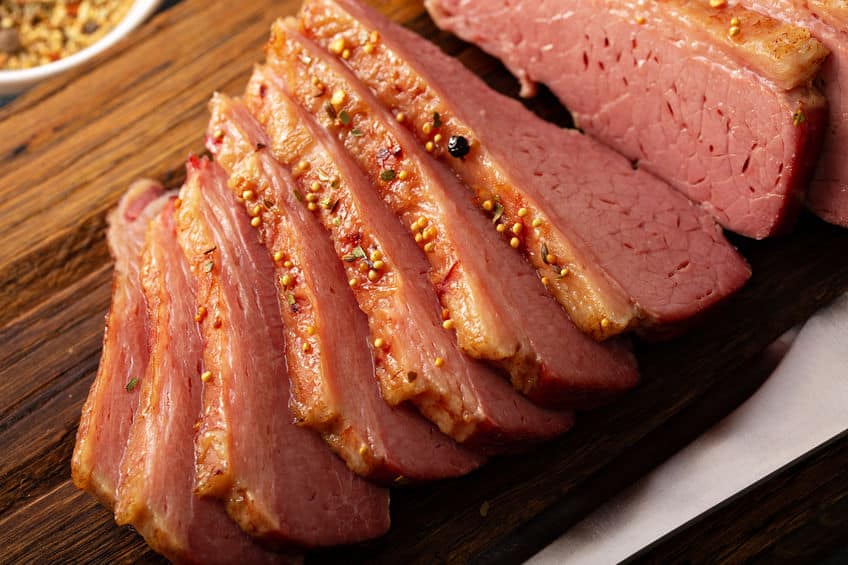By Kathy Driscoll –
Let’s face it, most of us are as Irish as Paddy’s Pig.
Of course, an awful lot of people still find a bit of green somewhere inside themselves come every St. Patrick’s Day as they’re the first to grab a green sweater, stick a Kiss Me I’m Irish pin on their chest and head off to the local parade. This ritual is usually followed by a sturdy effort to “drown the shamrock” with a nice thick Guinness stout while singing “Molly Malone” at the top of their lungs with some old comrades at a favorite Irish pub. Others, of course, may decide on an alternative celebration, perhaps dancing jigs in full leprechaun gear, green beer in hand.
And at the end of the day, what comes next? A steaming plate piled high with the traditional corned beef and cabbage, of course.
Can’t wait to dig in? Maybe you should.
Not trying to bash the Irish or those who love them, but that nice moist pile of meat is packed with sodium, up to 1,286 milligrams per four-ounce portion. That’s more than half of the recommended daily sodium intake and that’s not including the fat. Add in the prerequisite potatoes and the cabbage, and traditional St. Paddy’s Day dish is, in fact, a “caloric bomb,” Health In A Heartbeat podcast reports.
What’s the problem? Just like real estate, it all comes down to location, location and location. Corned beef is made from brisket, the lower breast area of the cow. It is considered to be tough and fatty. To tenderize it, brine with spices, including allspice, coriander, peppercorn, mustard seeds, and bay leaf, is applied, giving corned beef that slightly sourish, salty and meaty flavor. It’s exactly what’s wanted from a traditional St. Patrick’s Day dinner if not a favorite Reuben deli sandwich.
Whether that’s what is recommended for a healthy heart, blood pressure level or waistline is another matter.
Is restaurant fare any better? No, and it may be worse because that corned beef is likely to contain another nasty additive—sodium nitrite—a common preservative that limits the growth of bacteria but adds to the high sodium content.
Side dishes can help somewhat to defuse this bomb. Think about carrots sometimes nestled next to the meat and of course, that traditional cabbage. A half-cup of cooked cabbage, alone, offers up fiber, potassium, magnesium and Vitamins A, K and C—and a fair amount of the latter.
For all the nutritional bashing, corned beef isn’t without at least a few pluses registered dietician Anne Danahy wrote on Healthline.com. It actually has significant amounts of protein, Vitamin B-12 and Iron, which helps create healthy red blood cells. The meat is also high in selenium, an important nutrient for thyroid function that also plays an important role in making DNA.
The dangers of eating any processed red meat are already well reported. It can contribute to a higher risk of health problems, including high blood pressure and heart disease. Danahy also warns that cooked red meat is also a source of polycyclic aromatic hydrocarbons, heterocyclic amines and nitrosamines, which are formed when meat is cured or cooked to high temperatures (302-662F).
The World Health Organization even classified processed meats as a carcinogen, likely to cause cancer in humans. Other studies found that eating about 2 ounces of processed meat on a daily basis might increase the risk of colorectal cancer as well.
What’s a real or would-be Irish lad or lassie to do on St. Paddy’s Day?
Start by limiting any corned beef fix to a once-a-year event and look out for an extra-lean cut, advises University of Florida researchers. Take the nutritional vetting further by trimming off the visible fat and steam-cook the cut to reduce it even more. Better yet maybe look for a healthier alternative like pork tenderloin or a slow-cooked flank steak. “These dishes are just as mouth-watering, but have far fewer calories and sodium,” the Florida researchers say.
Okay, maybe they’re not as mouth-watering as the real thing, especially for those looking to tap into their Irish roots. But these leaner cuts just may mean there will be more Shamrock days to celebrate. And ultimately, digging into something other than corned beef on St. Patrick’s Day isn’t going to violate an ancient Emerald Isle tradition. Eating corned beef, in fact, is a purely Irish American tradition that took root around 1900. Chances are any relatives or ancestors celebrating St. Paddy’s Day in the old country would have done so with yes, some beer or Irish whiskey, but also a loin of ham, possibly spring lamb or a lamb stew, heaping with onions, celery, carrots and potatoes, of course.















